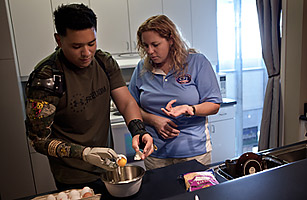
Corporal Sebastian Gallegos learns how to crack an egg with help of an occupational therapist at Brooke Army Medical Center
(2 of 2)
Gallegos' prosthetic is controlled by sensors on what's left of the bicep and triceps on his right arm. These muscles essentially act as a gearshift; flexing them in different sequences switches the prosthetic's mode from elbow to wrist to pincer. "He has to do mental gymnastics to move," Smurr explains. "It's frustrating because it's easier just to use your left hand. But you can overuse your other hand and get other injuries. The more we can teach someone to try and integrate and use two hands to do a task, the better off they are in the long run."
As impressive as BAMC's work is with amputees, the base may become more widely known for its innovation with limb-salvage patients. For every amputee in the Iraq and Afghanistan Wars, there are an estimated five or six patients with severely damaged limbs that doctors were able to save. Like amputees, these patients require extensive rehabilitation to learn to walk or use their arms again. And the pain and loss of function led dozens of limb-salvage patients at BAMC to request what's called a "late amputation," i.e., having a limb cut off months or even years after an injury. It was a startling trend with an equally surprising solution. "The reason why we had all these guys who wanted their legs cut off was that they wanted to run," explains Johnny Owens, a physical therapist and director of limb-salvage rehabilitation at BAMC. For high performing troops, running separates those who can do their jobs from those who can't. And amputation was sometimes requested by troops who wanted to get a prosthetic nicknamed a "cheetah leg," a curved, carbon fiber blade used by runners like South Africa's Oscar Pistorius, a double amputee who may be fast enough to compete in next year's Olympics.
Owens and his colleagues at BAMC noticed that the limb-salvage patients requesting amputations had fused ankles, severe nerve and muscle damage and could not generate enough power from their legs to jog, let alone run. So Ryan Blanck, a prosthetist at the Center for the Intrepid, designed a device called the IDEO, short for Intrepid Dynamic Exoskeletal Orthosis, that fits into the patient's shoe and runs two carbon fiber struts up the back of the calf to a cuff that attaches just below the knee. With the orthotic in place, Owens put the warriors through intense physical rehab based on sports medicine and taught them to run by landing midfoot instead of on their heels. The result: patients who could barely walk ten feet because they were in such pain were, within a week of special training, running, sprinting and jumping. The BAMC team developed a program called the Return to Run Clinical Pathway. More than 160 troops have gone through it since 2009; of those, more than 50 — including Navy SEALs, Rangers and Special Forces troops — have returned to active duty where they are jumping out of airplanes and fast-roping out of helicopters.
"It's not all about getting back to the military," Blanck says. "It's about getting back to life. Playing softball. Just being a coach for their kid's soccer or t-ball team. It's amazing how demoralizing that can be if you can't do that."
Blanck's team, which has published papers on the orthotic and has applied for grants to fund larger studies, wants to replicate the training program at other military bases and eventually create a version that can be used in the civilian world to help, say, a car crash victim walk again or get an injured construction worker back on the job. "This is a major game-changer for the military," Owens says. "Every conflict, something comes out of it — the M*A*S*H units in Korea, the nurses of the Crimean War. This could be the significant advancement to come out of this decade-long conflict."
But as cool as the physical rehabilitation is at BAMC, much of the emphasis here is on healing warriors' minds. This takes place in formal group therapy sessions, but also in informal ones that happen while watching football or playing video games. "This is an Army facility, but it's a gathering place," says Judith Markelz, who runs BAMC's Warrior and Family Support Center, a one-story building that looks like a giant version of a suburban home. Over meals, the troops and their families talk about how to deal with a new reality they never bargained for. "Plan A was to get married, have kids and see the world," Markelz says of many young military families she's been helping at BAMC. "We're on plan B."